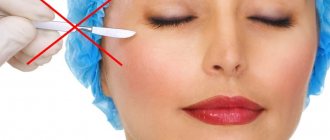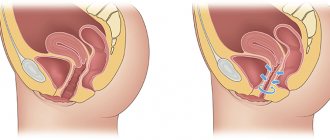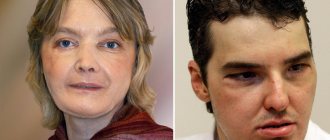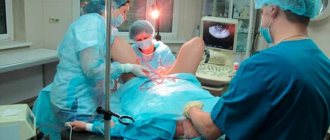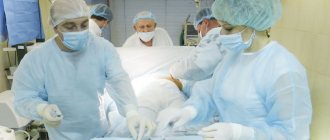Eyelid surgery helps to significantly refresh the face, give a rested look, remove age-related changes in the eyelids, and get rid of “tired” eyes and “bags” under the eyes. After all, it is by the eyes that a person’s age is determined, therefore, it is no coincidence that most patients who begin to pay attention to age-related changes in the face initially apply specifically for eyelid surgery, in order to obtain a pronounced rejuvenating effect.
Preparation for eyelid surgery:
- laboratory examination (tests);
- consultation with an endocrinologist and gynecologist (in the presence of swelling and pigmentation of the face);
- consultation with a dermatologist-cosmetologist (in the presence of dry, aging skin of the eyelids and face);
- consultation with an anesthesiologist (if the operation is planned under anesthesia).
Upper eyelid surgery.
Upper eyelid surgery creates an open semicircular fold of the upper eyelid, characteristic of a young age, removes fatty hernias and an overhanging fold of the upper eyelid, which significantly enhances the rejuvenating effect. Isolated upper blepharoplasty is performed under local anesthesia and lasts about 20-30 minutes, and in combination with the use of a laser to seal the vessels and reduce the skin of the eyelid, the operation takes place without bruising and retains the effect for a longer period. At the stage of preoperative marking, a natural fold of the skin of the upper eyelid is determined along which the cosmetic micro-suture will pass, therefore, after healing it is not noticeable. If there is a slightly overhanging skin fold of the eyelid, it is partially corrected. (occurs at a young age and is rather a feature of the anatomical structure). If the sub-brow part is not full enough, lipofilling is performed (transplanting one's own fat). If the eyebrows are drooping, it is possible to raise them at the same time as upper eyelid plastic surgery.
Indications for upper blepharoplasty
Upper eyelid blepharoplasty can be performed at any age. To perform the operation, one of the following conditions is sufficient:
- Presence of fatty hernias above the eyes. Under the skin above the eyes, many people often have heavy ridges that cover the entire eyelid, visually narrowing the eye and making the look gloomy;
- The presence of severe ptosis (sagging skin on the upper eyelids). This situation may arise due to the aging process of the body, or due to genetic predisposition.
Indications for blepharoplasty include both aesthetic imperfections and general medical problems. For example, ptosis of the skin on the upper eyelids caused by age-related changes can interfere with normal vision and contribute to poor vision.
Lower eyelid surgery.
Lower eyelid surgery will permanently solve the problem of bags under the eyes. will get rid of wrinkles and also make the skin of the eyelid more elastic. In the presence of only periorbital hernias and with good skin turgor, transconjunctival repair is performed from internal access from the mucous membrane - without skin incisions. The use of special tests and techniques during surgery makes it possible to determine with high accuracy the amount of skin and fatty hernias to be removed. Laser removal of hernias avoids the appearance of hematomas, forms a dense framework of eyelid tissues and increases skin turgor, thereby prolonging the result of the operation for >4-5 years.
Elimination of consequences
If you still cannot avoid complications after blepharoplasty, you will need a repeat operation. If you trust your doctor and are sure that the consequences are not his fault, you can trust him with the correction. If a doctor makes a mistake during an operation, it is worth looking for another clinic and surgeon. Only a doctor with extensive experience and qualifications will be able to assess the degree of complications and draw up a plan to eliminate them.
In some cases, drug treatment will help, but for more severe complications, surgical intervention is necessary.
Repeated blepharoplasty
You should not be afraid of having a repeat operation; a competent specialist will help correct the situation with minimal losses. Try to collect as much information as possible about surgeons and clinics where they perform blepharoplasty. Look for real reviews on the Internet, on forums or on the website of the clinic itself. A self-respecting clinic will not post false reviews about its specialists.
What is additional correction
In cases where surgery can be avoided, correction will help. This includes physiotherapy, lymphatic drainage or medication.
Remember that the responsibility for the successful outcome of the operation lies with you. It is up to you to find a professional who will perform the operation competently and as accurately as possible. On our website you can get acquainted with clinics that perform blepharoplasty in Moscow and other cities of Russia, study prices, equipment, and a list of surgeons.
Finally, we recommend that you look at photos of patients who have had unsuccessful surgery.
After operation
After eyelid surgery, a bandage is applied and eye drops are instilled to prevent swelling. There is no pain, bed rest is recommended for the next 2-3 hours. The cosmetic micro-suture is removed by pulling on 4-5 days absolutely painlessly. By the 6-7th day, minor swelling disappears and you can return to everyday life.
But according to most patients, the final result is determined only by the second or third month.
Non-surgical blepharoplasty
If your situation is not life-threatening, and the fear of complications is too great, it is worth considering methods of performing blepharoplasty without surgery. Here are the main ones:
- thermage;
- hardware;
- injection
- sms-lifting;
- thermolifting
Of course, these methods also have their drawbacks, but they are much less than those of operating procedures. One of the main disadvantages is the presence of swelling for some time after the operation. However, this lasts no more than a week.
Advantages of blepharoplasty without surgery:
- safety of the method;
- targeted impact on the desired area;
- low trauma;
- no pain during the procedure;
- quickly get the desired result
If you decide to undergo non-surgical blepharoplasty, remember that several procedures are necessary to obtain the desired result.
Age-related changes in the face according to Baker (hide)
PREOPERATIVE CONSULTATION.
Patient complaints.
“Ever since my youth, when I was 20 years old, I have always had the problem of drooping eyelids. Problems with makeup to apply a line of arrows. Accordingly, with age, the fold only increased and became worse and worse. Age-related changes cannot be avoided, the time has come, it’s time.”
Conversation between doctor and patient.
During the consultation, medical indications are determined. The patient has an excess skin fold of the upper eyelid. The first problem is that the crease hangs over and interferes with applying makeup; it can be a little irritating, especially during the period when there is slight swelling, as it gets larger and interferes with taking beautiful photographs. I don’t like his appearance, he’s tired and gloomy. The second problem is the position of the eyebrows. It's different for everyone. In this situation, the position of the eyebrows is quite low and this cannot be ignored, because the patient is indicated for 2 operations: plastic surgery of the upper eyelids and subsequently endoscopic brow lift.
Taking photographs.
Medical photography is a standard procedure related to medical documentation. You cannot perform aesthetic surgeries to change your appearance or correct age-related changes or birth defects without photographs. We need photography to evaluate the results before and after. Photographing is performed in 3 projections: frontal, lateral and semi-lateral, with eyes closed and open. In these positions it will be clearly visible what excess skin of periorbital hernias was before the operation and what result we will get in the end.
Marking.
An important step before surgery. At the preoperative marking stage, it is important to assess the volume of skin that is to be removed. It is known that there are certain limits, these are 9 mm from the eyelash edge and 15 mm from the eyebrow growth line. Within these limits, the skin fold can be removed. You cannot remove any more, otherwise you may get a noticeable scar that will not fit into the fold of the upper eyelid. You may also get the effect of emptiness in the area of the upper eyelid, which makes you look older and gives you age. And our goal is to get a rejuvenation effect. Therefore, it is important to consider how much skin and fatty periorbital hernias to remove. You can't do hypercorrection, because... This will make you look older and look exhausted. It is better not to remove more tissue than to go through it during surgery. But another important point is that when we potentially know that there will be a brow lift surgery, we should not remove too much skin. Otherwise, in the future, when raising the eyebrows, there will be excessive tension, as well as the effect of emptiness of the upper eyelid and tension when closing the eyes. But another important point is the cut. When we first perform upper eyelid surgery and then endoscopic brow lift, we must take into account how we will draw the incision line, since when the eyebrow is raised, the incision may extend onto the eyebrow and become noticeable.
How does healing proceed after blepharoplasty?
Patients who decide to improve their appearance and refresh their eyes with the help of blepharoplasty are always interested in the rehabilitation process and its duration.
This question is one of the main ones for potential patients who are still just thinking about the possibility of surgery. Related questions also arise. How soon will it be possible to go back to work? Will the scars be noticeable? When can you wear contact lenses? What means can you use to quickly get rid of swelling? How long will it take for final healing? In this article, we will describe in detail how rehabilitation proceeds after blepharoplasty of the upper eyelids and transconjunctival plastic surgery of the lower eyelids, and we will give answers to your questions. And in conclusion, we will offer tips that will help speed up rehabilitation after blepharoplasty.
How long is the standard rehabilitation period?
Blepharoplasty is a relatively simple and low-traumatic operation. The risk of complications is minimal, they practically do not happen. The standard rehabilitation period is only 14-16 days. For many patients who strictly follow the plastic surgeon’s recommendations, the postoperative rehabilitation period is reduced to 10 days.
The healing process after blepharoplasty is somewhat prolonged due to the following factors:
- patient age over 45 years;
- there is a tendency to edema;
- the skin is thick;
- there are individual characteristics of the skin in the eye area that prolong the rehabilitation process;
- the patient smokes.
After upper blepharoplasty and transconjunctival lower eyelid surgery, a hospital stay is not required. The patient can go home immediately. Relatives are advised to meet him in a private car or take a taxi, since the eyes are not fully open immediately after the operation and the gaze may become blurred.
Painful sensations after this operation are either absent or insignificant and can be easily relieved with painkillers prescribed by the doctor.
Natural consequences of blepharoplasty during the healing period
During postoperative rehabilitation, the patient may experience:
- moderate swelling;
- small bruises localized under the lower eyelids;
- feeling of heaviness of eyelids;
- increased lacrimation;
- dry eyes;
- soreness;
- blurred vision;
- diplopia (double vision).
We emphasize that the patient does not always experience all these side effects. Usually only a few symptoms from the lists appear.
These side effects of blepharoplasty usually go away within 7-10 days. Residual swelling can persist for up to two months, depending on the individual tissue response to the new location. Proper skin care, which we will discuss below, helps to quickly solve the problem of residual edema.
Will there be scars after blepharoplasty?
This is probably the most common question that plastic surgeon patients ask. There is no need to worry about scarring, since the surgeon makes incisions in natural folds of the skin. There is a stereotype that the seams are less noticeable if blepharoplasty is done using a laser. But that's not true. When using a laser, the edge of the wound is burned, which makes the scar more noticeable than when using a super-sharp scalpel. In general, the quality of the postoperative scar depends on the skill of the plastic surgeon and the individual characteristics of the patient’s skin.
Rehabilitation calendar
1 day. You can go home immediately after the operation. It is recommended to apply cold to the eyelids to reduce swelling. It is worth taking a painkiller. 2-3 days. You can take a shower and even wash your hair (be careful not to get shampoo in your eyes). Use antiseptic drops prescribed by your doctor and do recommended eye exercises. You can read a little, but in moderation so as not to overload your eyes. 3-5 days. Visit a clinic to have your stitches removed (if they are not self-dissolving). You can wear contact lenses. Day 6 All antiseptic stickers (plasters) are removed from the eyelids. Day 7 Most patients experience bruising and swelling. As a rule, the patient returns to normal life and goes to work. Day 10 Traces of hemorrhage are reduced to a minimum. If there are no complications, you can use decorative cosmetics (it is advisable to choose products for sensitive eyes). Day 14 You can gradually resume your usual physical activities. 45-60 days. Residual edema disappears completely. Post-operative scars become completely invisible even without decorative cosmetics. The effect of eyelid surgery becomes clearly visible.
What is prohibited and what is not recommended to do during the rehabilitation period?
To ensure healing is as successful as possible, follow these simple recommendations:
- do not drink alcohol or smoke (strictly prohibited);
- do not eat salty, sour, spicy foods during the rehabilitation period;
- protect your eyes from sunlight and wind for six months (this can be done with glasses);
- after the operation, get plenty of rest and avoid physical exertion, especially those that increase intraocular pressure (lifting heavy objects, bending over);
- refrain from intense exercise for a month;
- for several days, try not to watch TV, use a computer or read (this causes dry eyes);
- try not to cry or blink frequently;
- do not sleep with your head down;
- Do not take too hot a bath or go to the sauna.
How to reduce swelling after blepharoplasty?
To ensure that swelling goes away as quickly as possible after surgery, follow these recommendations for caring for the skin around the eyes:
- I need to remove the special tape applied to ensure the correct placement of the tissues;
- regularly use medications prescribed by your doctor (ointment, eye drops);
- apply cold compresses to the eye area;
- sleep with your head elevated;
- drink more water;
- Perform the exercises recommended by your doctor to restore muscle activity in the eye area, eliminate lymph congestion and improve blood circulation.
To quickly relieve residual swelling, 7-14 days after surgery you can sign up at a cosmetology clinic for lymphatic drainage massage, moisturizing treatments and lifting. Botox to smooth out facial wrinkles can be done 1.5-2 months after eyelid surgery.
The information on the site was personally verified by plastic surgeon Maxim Aleksandrovich Osin; if you have any additional questions, call the phone number listed on the site.
OPERATION.
Local anesthesia.
Incision.
Removal of hernias and excess skin.
A piece of skin from the upper eyelid.
Applying a suture.
Applying strips for fixation.
The operation is completed.
Rest in the ward after surgery.
How to consolidate the result?
To increase the duration of the effect of plastic surgery, it is important to choose the right clinic and doctor. The clinic must have a license for medical activities and be well equipped. The surgeon must have a diploma from a medical school and have sufficient qualifications and experience to perform eyelid correction.
It is also necessary to strictly follow the rules of rehabilitation. For example, for a month you cannot play sports or be exposed to physical activity, visit baths and saunas, or take a hot shower or bath. It is necessary to protect the skin from ultraviolet radiation. If these prohibitions are violated, the patient can expect various unpleasant consequences, from the appearance of noticeable scars to a decrease in the effect of the operation.
Dressing for 5-7 days.
On the dressing we see that the skin has healed perfectly, the process of epithelization has completely occurred. The seam looks like a thin narrow pink stripe, which will turn white over time and become even less noticeable. We see that the cut is located in the correct position, in the fold, which also ensures its inconspicuousness. But at the same time, we see that the skin fold at this stage is swollen, that is, there is a little more skin than needed due to swelling. The patient asks me: “Sergei Vladimirovich, was it possible to remove more skin?” How to answer this question? Of course it is possible, but then there would be a void in the upper eyelid, which would give age, rather than a rejuvenation effect. If I removed all the skin, we would get significant changes in the upper eyelids and this could become very unusual for the patient and the patient could be upset, but most importantly, there would be an emptiness effect. The skin of the upper eyelids is now swollen, stretched, and the skin hurts. But when 4 months pass and the swelling completely goes away and the skin of the upper eyelid shrinks. The excess that exists will go away in 4-6 months due to skin contraction. In addition, we need a small excess so that we can perform a brow lift in the future. If we completely remove all the skin and then we decide to perform an endoscopic brow lift, a situation may arise where there is not enough skin, there will be excess tension. In this situation, there will be contraindications for a brow lift, so in this case the skin is removed with the expectation that the next brow lift operation will be performed and the skin will be completely straightened, and there will be no excess, and there will be no emptiness of the upper eyelid, this is very important to plan sequence of the operation and at each stage to obtain a good aesthetic result.
Check-up in a month.
Comparison of before and after results.
The patient asks me: “Sergei Vladimirovich, could you have removed more skin, you see, I still have a small fold left?” Of course, it was possible to remove it, but with a brow lift, a skin deficit would then arise. After all, a brow lift moves the skin of the upper eyelid higher. If, at the first stage, with eyelid plastic surgery, we remove all the skin, then at the second stage, after 6 years with a brow lift, we will not have enough skin to move the eyebrow upward, because the skin of the upper eyelid is also pulled up behind the eyebrow, so this a small excess was left specifically in the expectation that we will perform a brow lift in the near future, since there are indications for raising the eyebrows, that is, the patient has drooping eyebrows. When we plan such a 2-stage approach, we must take into account what we will have if we remove more skin, how the condition of the tissues will change, whether we will have enough skin for a brow lift if we remove it all, where we will end up with a seam after eyelid surgery if we then perform a brow lift. All these moments need to be predicted at the stage of eyelid surgery. If, on the contrary, we first perform a brow lift, and then 10 months later an upper eyelid plastic surgery, then we would remove as much skin as we need, since the tissue would already be moved due to the brow lift and we would not have to leave a small reserve of skin for centuries.
Comparison of results after 1 month.
Comparison of results after 6 months.
Comparison of results after 1 year.
How long does the result last?
Blepharoplasty gives a high-quality visible effect that lasts for a certain time. It is impossible to say the exact period during which the results will last. It depends on many factors. Some of them depend on the doctor and the patient himself. This includes the qualifications and experience of the doctor, the quality of the operation performed, and the patient’s attentiveness to compliance with recommendations during the rehabilitation period.
On average, the effect lasts for 7-8 years. With proper plastic surgery and high-quality rehabilitation, it is possible to increase the period to 10-12 years. In addition to violations of rehabilitation rules or poor quality of correction, the individual characteristics of the body can reduce the term. Fortunately, such features are very rare. Most patients do not seek re-correction until 10 years after the first.

